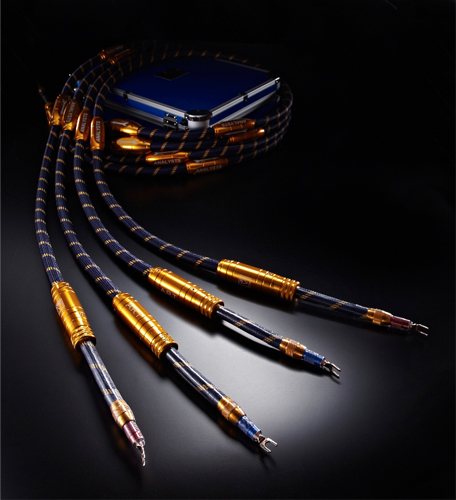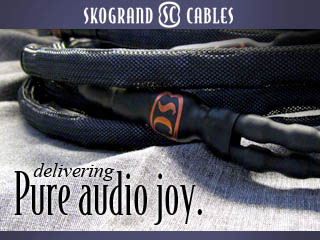The audiophile mind treats cables differently than components. Be it a turntable, digital player, preamplifier, power amplifier or speakers, we are comfortable in putting our finger on what has changed and what improvement has been wrought, because it is easy to describe fundamentally different designs in the product category. This is precisely one reason cable reviews can be hard to write, not because one cable is necessarily inferior to the other, but because the true innovators are imitated and copied ferociously. The resultant products can be so much alike in constructions, materials used and performance.
Hence my relegating of my longstanding preference of reference products in this group to the top offerings from three companies: MIT Cables for its superior system-adaptive nature via Bruce Brisson’s groundbreaking networks, Wireworld for David Salz’s incomparably exclusive flat conductor technology and Audio Note UK for its high-purity, high-strand silver in the darnedest, most technology-less, straightforward construction of its cables. People laugh at the Audio Note UK’s lack of technology in the construction, and their jaws drop when I play it. Those expensive strands of silver are not for nothing.
The priority and mentality of the reviewer, which is not the same as our readers, also comes into play. When an audiophile auditions a product, he wants to know if the sound of that product is compatible with his tastes and goal, because he is spending his hard-earned cash to get what he wants, and he walks into a store with his glass more than half full. This is as it should be. For a reviewer, his job is to zero-in on the true nature of the product auditioned as closely as possible, and then describe it. Except in the case when the sound of the product is a far cry from what he is accustomed to, like having a reviewer known for his penchant for multi-driver, extended-range speakers write about a pair of single-driver, limited-range design, the reviewer will usually have no problem appreciating the strengths and weaknesses of the product and reporting them as such in a balanced approach.
Cable reviews, however, are very different. In addition to the reason stated in the first paragraph, the current, prevalent mentality continues to be one in which many readers hope to elevate the performance of his system by replacing one set of interconnects or speaker cables; but the reality is the introduction of any given cable changes the chemistry of the system, which is then perceived as better or worse. A superior cable, such as the MIT Oracle V1.3 HR speaker interface, can make the system sound just the same if used in conjunction with a whole system of inferior cables and electronics. In addition, if all a cable does is passing signals along without active processing, then its presence will make a system behave differently because of its interaction of differing impedance and capacitance with other cables, among other factors, whether it’s replacing one set of interconnect or speaker cables versus a complete system rewiring.
I have had the privilege of using complete cable systems, and this have allowed me to delve into the core of the cable systems’ intrinsic character. Robin Loggie, owner of Loggie Audio of Redwood City has been using MIT Oracle Series of cables costing in the $50k range for a long time in a $189,000 system of Esoteric P-02/D-02 ($47k), Ypsilon PST-100 tube preamplifier ($37k), Ypsilon Aelius hybrid monoblocks ($36k) and YG Acoustics Anat III Studio Signature loudspeaker system ($68.8k) to magnificent effects. When Robin demonstrated the sound of his system as wired by the less expensive, $26k A.R.T. Super SE interconnects and speaker cables to me, I found it surprising that the musical enticement of his system was not impeded by a non-network cable. Rather than fleshing out details in manners consistent with other high-end, non-network cables, the Super SE portrayed sound in a very exotic manner via its comparably conventional and costly but nonetheless effective method. Uniquely, the Super SE imparted considerable complexity in recreating tonal palettes, an ability not observed even from the Audio Note UK high-strand SOGON silvers, although concession must be made here that the SOGONs are designed specifically for use with the company’s SET amplifications. I would return for a few more times to Robin’s listening room and eventually commandeer his complete A.R.T. Super SE cable system for review.
Audio Reference Technology was founded by Luigi Basagni in 1983, who is also the chief engineer. Luigi was somewhat of a secluded personality with heavy involvement in the world of formula-one racing. That is all I am privy to disclosing, per James Liu, the company’s U.S. representative here in the Bay Area. Nowadays, the company is being run by David Huang, who used to be Luigi’s dealer for over twenty years. In Laurence Borden’s Interview article of A.R.T. Cables, Luigi mentioned about his strive for creating a speed of sound by the use of select conductor/terminal combination. After spending considerable time with the cables, I could see how those two formed a symbiotic block that deliver wholly formed transients.
Five levels of cable systems form the core of the A.R.T. SE product line. The “SE” designation points to the incorporation of anti-electromagnetic plating in the metallic shielding of plugs and filter structure. In addition, a “Q-Damper” technology of magnetized CNC aluminum alloy rings are positioned throughout the entire length of the cables of this series to further enhance isolation properties.
- (Page 1 of 3)
- Next page →

